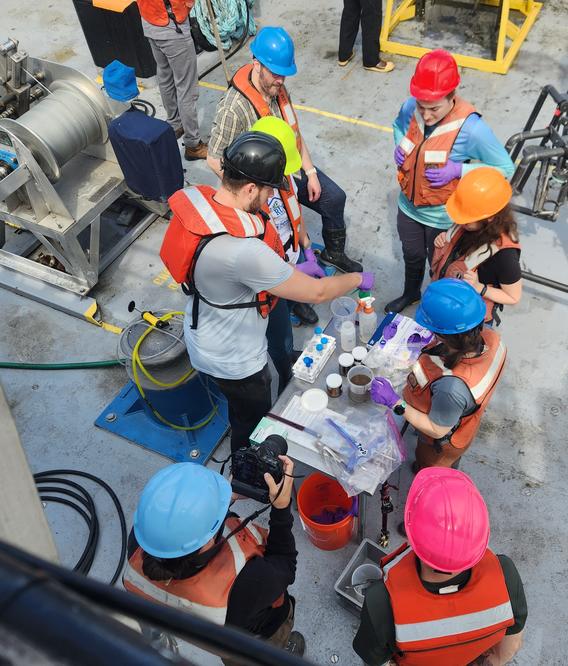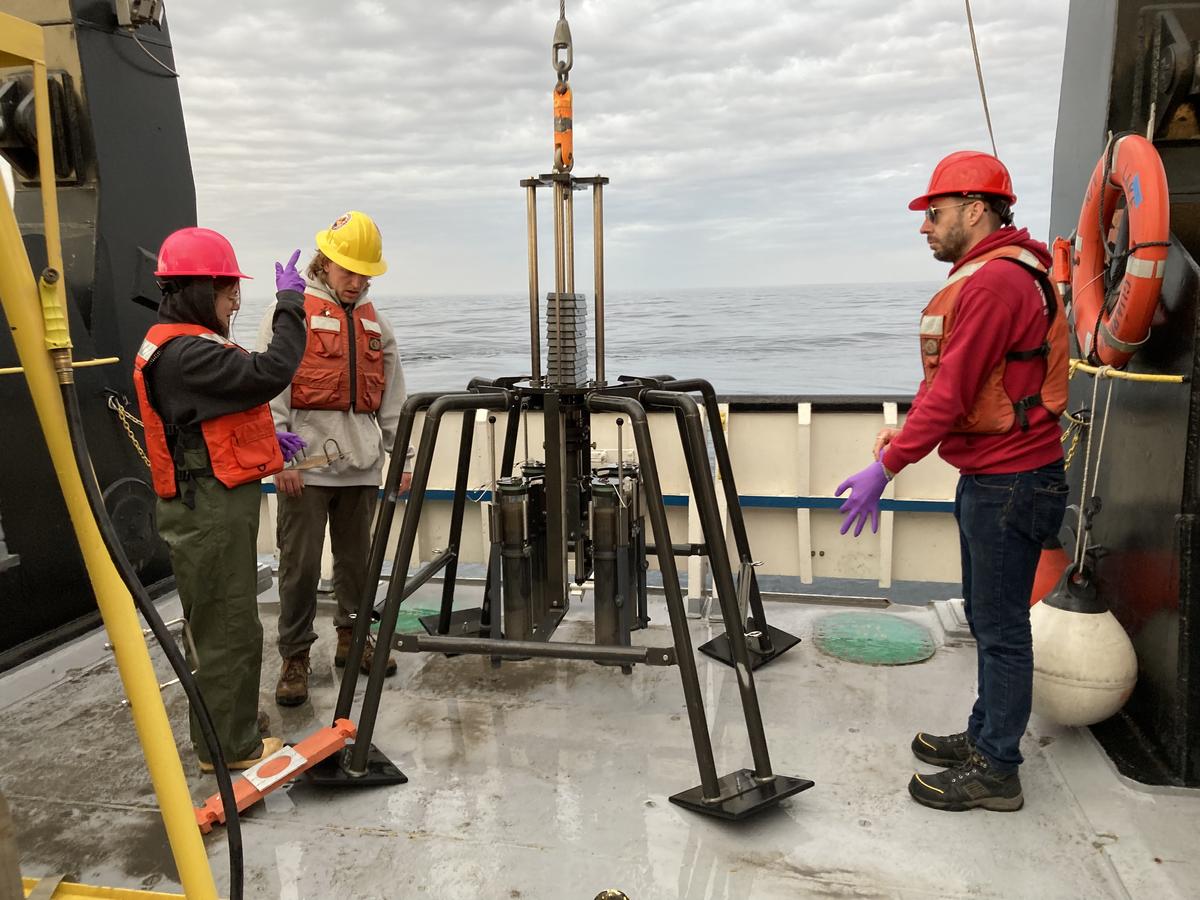Understanding how pollutants flow through watersheds is well studied. We know that nitrogen fertilizers, for example, flow off lawns when it rains into nearby creeks and lakes. Plenty of contaminants also flow from our streets into water systems.
So scientists expected to see concentrations of contaminants near tributaries when they started the Great Lakes Sediment Surveillance Program in 2020. This massive effort, funded by the Environmental Protection Agency and led by NRRI, is identifying and analyzing legacy and emerging contaminants in surface sediments and deep sediment cores collected throughout the lakes. They are now getting results from data collected on Lake Superior and Lake Huron.
Interestingly, high concentrations of contaminants were found in the deep, middle of the lakes, rather than just the near shore areas. So now the team is looking closely at, not just the watersheds, but the airsheds, too. Pollutants get into the atmosphere and are moved with the wind and deposited when it rains. Some will attach to sediment which move with currents to deeper parts of the lake.
“We're seeing large changes in the concentrations from near shore to offshore, especially with some of the heavy metals I've been looking at,” said Chris Filstrup, principal investigator on the project. “They are more highly concentrated in the center of the lake rather than near most, but not all, tributary sources.”
What and Where?
The goal of the five-year study is to understand the extent of contamination in the lakes – from legacy chemicals to emerging pollutants – and how they move through the system. The findings will lead to improved management strategies that more effectively target potentially harmful contaminants to protect the ecosystems and human health.

“We want to know more about the sources. Are they coming off the landscape or from wetlands or from where in the atmosphere?” said Filstrup. “And once the chemical gets into a lake, is it taken up by algae and then eaten by fish? Or does it settle out and stay undisturbed in the lake bottom?”
There are many questions to be answered, confounded by the depth and breadth of the Great Lakes and the 250 target contaminants – including 40 different PFAS ‘forever chemicals’ – being investigated for this study. And while a similar study was done some 10 years ago, the data collected then doesn’t compare well with the data collected today because of the finer details newer technologies can gather, and updated analytical methods.
“We’re adapting and adding new analytes – pesticides, for example – and we are also looking for new PFAS,” said NRRI Environmental Chemist Bridget Ulrich. “Some estimates say there are over 10,000 of these per- and polyfluoroalkyl substances, but we’re only measuring the concentrations for 40 that are included in standard methodologies. So we are also using non-target screening methods to identify new PFAS that could potentially be included in targeted measurement methods for future surveys.” Ulrich is also a Co-Principal Investigator for this program, leading a team of four scientists to perform the trace organic contaminant analyses for the sediments.
Sediment Collection
The core samples are collected from three sites on each of the five Great Lakes and shallow surface sediment samples at about 30 sites per lake. Going to the deepest sediment deposits allow scientists to go back some 200 years in the depositional record to see when concentrations of certain contaminants peaked and if the amounts entering the lakes are decreasing over time. Scientists will use the surface samples to identify contaminated hotspots – areas of the lake where contaminants are accumulating.

According to Ulrich, they’re finding that legacy contaminants that have been regulated are being buried deeper within the sediment as time passes and new sediments settle on the surface. A new Gas Chromatography Triple Quadrupole Mass Spectrometer was installed to analyze legacy organic contaminants like polychlorinated biphenyls (PCBs) used widely in electrical equipment and polycyclic aromatic hydrocarbons (PAHs) from coal, crude oil and gasoline.
In addition to measuring emerging contaminants such as PFAS and neonicotinoid pesticides, the scientists are also performing nontarget analyses to detect new unknown contaminants. This required onboarding a new Liquid Chromatography Quadrupole Time-of-Flight High Resolution Mass Spectrometer. It can both measure contaminant concentrations and detect unknown contaminants, such as those that form in the environment due to degradation of other contaminants, and unknown chemical mixtures present in commercial products.
“At the beginning of the project it was challenging to comprehend the amount of effort it would take

to implement this portion of the program,” said Ulrich. “We not only had to onboard and train new scientists on these highly sensitive technologies, we also had to develop our own in-house protocols that align with new EPA standard methods that had just been released.”
Katie Schreiner at UMD’s Large Lakes Observatory is leading the effort to understand how the contaminants are transported within the lakes, which chemicals bind to what resources in the lakes – like organic matter or clay – and if it will cause bioaccumulation in the food web.
“Inorganic ions with a negative charge, such as dissolved phosphorus, bind to clays, which contain aluminum with a positive charge,” said Filstrup. “Once it binds, the contaminant is transported wherever that clay goes.”
Multidisciplinary
This extraordinary effort requires expertise from many science disciplines. (Team leads are listed in this 2020 grant announcement.) A paleolimnology team is charged with coordinating the surface sediment and sediment core sample collection and initial processing and physical analyses. Bulk analysis of the sediments and composition of organic compounds and how they influence contaminant transport will be done by a team from UMD’s Swenson College of Science and Engineering. A civil engineering team will characterize the lakes’ microbial communities and how the microbes may affect contaminant movement from the sediments back into the water. A collaboration with the U.S. Geological Survey Mercury Lab in Madison, WI is providing additional expertise in mercury and methyl mercury concentrations.
“People hear about this effort and are astonished by the amount of contaminants we’re analyzing,” added Filstrup. “In the end, we’ll have a really comprehensive chemical fingerprint at each site and better understand how these contaminants move in the lakes.”
Being able to predict where known and emerging chemicals are in the valuable freshwater resources of the Great Lakes will inform efforts to protect the environment and keep humans from being exposed.
PHOTO TOP: NRRI Scientist Elizabeth Alexson points as she watches a core sample being lowered into the research vessel during the 2023 field season on Lake Huron. (Credit: D. Edge)
